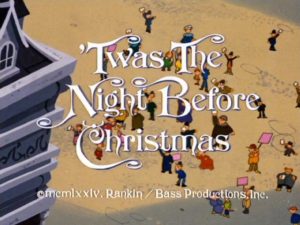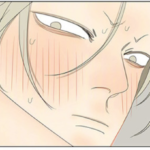
Well, we’ve already watched Rudolph the Red-Nosed Reindeer and Frosty the Snowman, but there’s one more famous character who made a trilogy of films with Rankin-Bass set in a shared continuity. Today we’re watching the film that got to the origins of Father Christmas once and for all. Look out boys and girls, Santa Claus is Comin’ to Town!
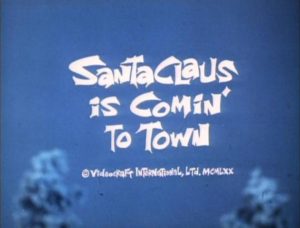
In a throwback to Rudolph the Red-Nosed Reindeer’s influence, we open Santa Claus is Comin’ to Town with newsreel footage. Unlike Rudolph, however, it’s not an effect done for nostalgia or to highlight the whimsical aesthetic of stop-motion by contrast. There are drums playing over the footage, and a stern narrator speaks of the “monumental efforts not to cry and not to pout” children are undertaking across the globe. We’re looking at a worldwide issue with real consequences, with a sense of urgency to the effort. This is the wartime movie Rankin-Bass always wanted, the greatest hero to children directly confronting the fascist state.
Our narrator, Fred Astaire as Special Delivery Kluger, reads from his sack of letters all the questions kids have asked about Santa. It’s overtly an origin story. This is the character we probably know most about, and Rankin-Bass is going in full-throttle into telling us everything we want to know. We’ve seen two distinctly separate versions of Santa throughout the Rankin-Bass canon so far. The first, seen in Rudolph the Red-Nosed Reindeer, as a fairly grounded and flawed man. The second, seen in Frosty the Snowman, felt much more mythical, holding our hand through difficult portions of the script as a comforting presence. Santa Claus is Comin’ to Town presents a third version, and one whose longevity will prevail for three films following this production. This is an investigative film. A character study that builds the basis for all Rankin-Bass Santa Claus appearances to come.
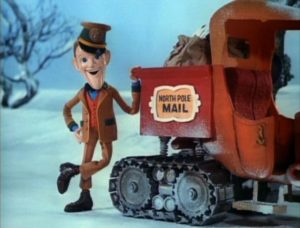
Cleverly, as if in direct response to the two previous opposing versions, Santa Claus is Comin’ to Town starts Santa as an orphan. They give us answers about the origins of Santa without telling us everything about where he came from. When we first see him as an adult, it’s Mickey Rooney as Santa. This is the big guns being brought out. They’ve done away with hiring just anybody who was available in Canada the day of recording, Santa Claus is Comin’ to Town is star studded affair all over. For Santa in particular, you need someone endlessly charming and likeable. In this regard, actually casting Mickey Rooney was a no brainer. He’s going to be the anchor that holds us through this grim and depressing narrative, the Steve McQueen in The Great Escape (another film considered a Christmas classic in the UK) and to do that, you really need that ever-present chuckle.
Did I say grim and depressing? Sorry, some spoilers there. But not for long. Because as soon as you see Sombertown, you realise one important thing that makes a wartime reading of this film even darker: we’re in Germany.
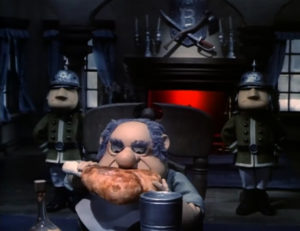
The visual design of the town in Santa Claus is Comin’ to Town is the special’s strongest aspects. It’s as Germanic as they come, with dark stone structures, lederhosen, and soldiers milling about in pointed helmets. It’s also entirely German Expressionist in the style as The Cabinet of Doctor Caligari. Expressionism was a style that embraced the artiface of film, revelling in constructing non-realistic, obviously fabricated visuals that outwardly reflected the societal themes of madness and betrayal that were so much in the German air in the period following WWI. That makes so much sense in a stop-motion environment. You can’t get more non-realistic than characters physically made out of wood and felt.
Sombertown is the domain of Herr Burgermeister Meisterburger. If there were ever a way to explain fascism to children, it’s through this character. Meisterburger rules Sombertown with an iron fist, enforcing laws in accordance to his whims and feasting on meat and wine while his citizens starve themselves to death. In a pivotal sequence in Santa Claus is Comin’ to Town, Meisterburger trips on a misplaced toy so he bans all toys flat out. He is left injured in body, but not in spirit. The Anti-Santa is truly born.
But getting back to Santa, we first encounter the orphan Claus abandoned in the woods. A redheaded babe, he’s adopted by high pitched elves named Kringle. They make toys alone, not giving them to anybody but merely because that’s what they do. These characters seem like a throwback to traditional Germanic folklore. Their naturalistic woodland wonderland contrasts hard against the Expressionist urban greys. The fact that these creatures were once toymakers to the King, now fallen from grace, is a secondary enforcement of their connection to the past. Society has evolved away from these whimsical, optimistic characters. Their presence is a spark, ready to set the fire of goodness once more. Who better to influence Santa Claus in his formative years?
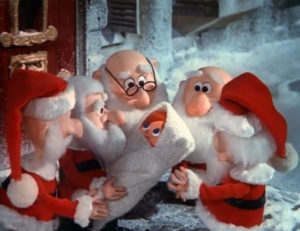
The Winter Warlock is an interesting new character in this story. At first, he’s introduced as Bumble was, a fearsome myth that lives on the fringes of society. As a child, I was 100% convinced this character was played by Dom Deluise, but I was also a child of ‘90s animation, so he was really only one of a few voice actors I could identify by name. The real star behind the Winter Warlock is Keenan Wynn, a character actor with nearly 300 listed roles. At first, it seems a direct copy of the Rudolph model, but the differences in how the Winter Warlock’s story plays out will justify this reliance on old tropes to introduce him.
We’re also introduced to a penguin named Topper. He belongs in a South Pole, and Santa declares him “about as lost as you could ever be.” What’s his purpose in the story other than to be a cute animal sidekick? He doesn’t have one. This is definitely the influence of Frosty the Snowman reeling its head on the film, and while Topper doesn’t really make sense here, he’s pretty fun and I don’t consider it an overall mistake to include this whimsical character in the film.
Santa’s first visit to Sombertown is one of blind optimism and hope. The folly of youth, he believes spreading goodness and cheer will be enough to change the status quo, but the children of this town have no need for toys. They know people judge you for how many chores you do and how clean your stockings are. I just have to mention again how visual cohesion is just off the charts in this movie! These kids actually have subtly grey hair. They’ve lived their entire life under wartime austerity.
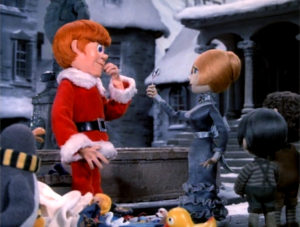
And here we fully embrace our title song as Santa makes his mission known. Santa angrily yelling “I’m TELLING YOU WHYYYYY” at a terrified child is the greatest line reading in the history of film for the sheer absurdity of the performance, but it also has purpose. Santa is frustrated by how little joy these children have been allotted, furious at the essential qualities of childhood which have been denied to them. He’s seen their town for what it is and he intends to liberate them. He’ll fight the fascist state from the inside.
But first, there’s a standing threat to be dealt with. You’d think that’d mean a fight, but honestly, the Winter Warlock is so incidental to the plot of this film in that regard. Santa defeats him instantly by making him a friend. I love it, because it shows the unique strengths of Santa Claus as a character. He’s a pure soul. Again I applaud Rankin-Bass for casting Mickey Rooney who laughs his way through every line coming out of Santa’s mouth. Look at how blue Santa’s eyes are. You can’t say no. What does the Winter Warlock, or, as he’s soon to be known, just Winter, represent? Is he an embodiment of the anti-Jewish sentiment in the German community of the time? The visual clues certainly point that way, the icy old man with the long beard and large crooked nose. Yet when Santa befriends him, the Nosferatu-like facade literally melts away, revealing a much more realistic man underneath. By embracing Winter, Santa bypasses prejudice and stands firm to fight the fascist state on all sides.

Delivered at night, down the chimney. He has to hide the gifts in stockings in order to hide them. Why? Because the Sombertown police force conducts nighttime raids on the houses they suspect may be hiding toys. RAIDS?!?! Seriously?! Look, I’ve tried to look for complex readings where I could in these films, reading the themes that were present below the surface. The fascist reading of Santa Claus is Comin’ to Town is just so obvious it doesn’t even make sense.
This part of the film ends when the guards arrest not just the Kringles, but Winter, Santa, and the penguin. Our entire cast are imprisoned as enemies of the state. Their cause is seemingly lost and we witness the darkest point of that fact with Burgermeister burning toys in a pyre in the middle of town. I thought I imagined that part when I remembered that part because it was so dark. But no. Toys are ripped out of children’s hands and burned in front of them. It’s a goddamned massacre.
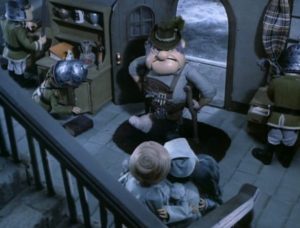
From this, we move into Jessica’s drug trip of a song My World is Beginning Today. The most 70s sequence. You could argue that, in the same way Santa brought the sudden burst of colour and animation into these otherwise dreary lives. Jessica herself is irreversibly changed by his cheery optimism, and the mix of stop-motion and animation together in this sequence is a triumphant orgasm against the grey Sombertown palette that made up her previous life.
The final scenes of this special end with a beautiful wedding. Santa is still a young man by the end of the main narrative, on the run and wanted by the law, but he is surrounded by love and optimism on all sides. His side will eventually win against the tyrant. He grows a beard to avoid being spotted due to the numerous Dead or Alive posters. There are a few other scenes that round out the details of Santa’s mythical status (although oddly, not his apparent immortality or how he in any way shared that innate ability with Jessica) but it is all incidental. At some point in an origin story, you need to know when to let go and let the audience piece the rest of the story together.

What is important, and one of the most beautiful aspects of this entire special, is how Santa Claus is Comin’ to Town actually handles the fall of Burgermeister as a dictator. That is, they fully imply that he lived out the full longevity of his dictatorship without repercussion. It’s only after years have gone by, after other leaders have both come and gone, that his legacy is left forgotten to the dredges of time. It’s a starkly realistic depiction of dictators. An iron grip can never outlive the man who wields. Good always outshines bad in the pages of history when written by the morally victorious.
Ranking this film is difficult for me. It’s one of my favourites to watch when it comes on TV, but much of what I loved about it directly correlates to how infrequently it was aired compared to Rudolph the Red-Nosed Reindeer and Frosty. I think it has one of the more complex depictions of society, and is probably the most relevant special for 2016 in particular, but it’s also the first time that the voice actors outshine their characters, and in placing the narrative in such a particular time and place, it loses some of the timeless elements that make Rudolph and Frosty stand out.
1. Rudolph the Red-Nosed Reindeer
2. Frosty the Snowman
3. Santa Claus is Comin’ to Town
4. The Little Drummer Boy
I’ll settle down for a long winter’s nap before we move on to the next special on our schedule: ‘Twas the Night Before Christmas!
